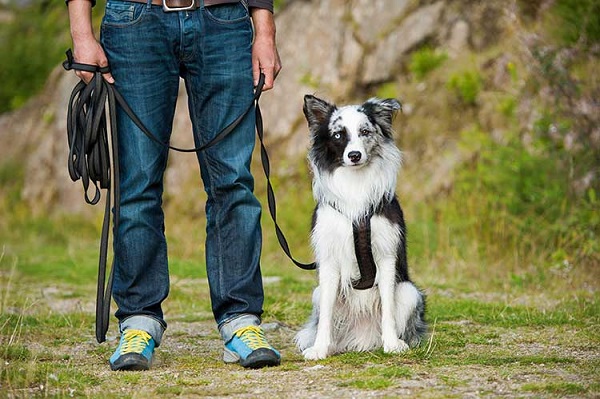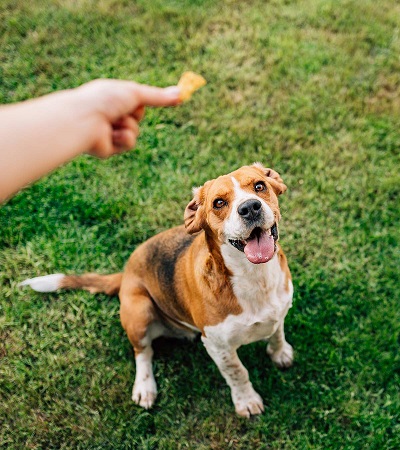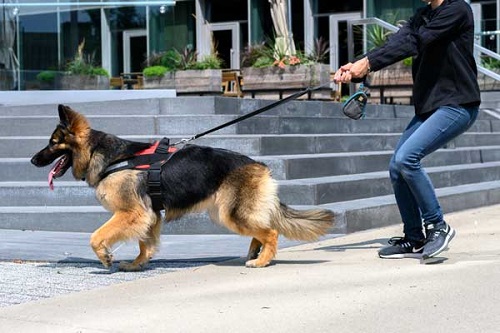You adopted an older dog, to later realize he becomes completely anxious when it comes to socializing. Leashes and collars are not his best friends, and now you find it daunting to train him from the very start.
Key Takeaways
- Older dogs can be difficult to leash train, but it is important to do so in order to socialize them.
- To leash train an older dog, you will need a few things: the right collar h trainiand leash, dog treats, and patience.
- The first step is to get the right fitting collar and leash, and then to teach the heel command.
- Start by teaching the heel command, and rewarding your dog when he obeys. If he gets excited or starts to pull, stop and command “heel.”
- Be patient and consistent with training, and avoid using punishment as a training method.
- eventually your dog will be able to walk on a leash without pulling.
But before we even begin, all new senior dog parents should know that leash training an older dog is similar to training a puppy or an adult dog. You will just need to add a little more of your patience and effort to their leash training.
In fact, older dogs are calmer and more excited about learning new things than most puppies and adult dogs, which makes leash training a fun task. So before we begin with steps, here are a few things you should have before you start leash training your furry friend.

Things You Need Before You Start Leash Training Your Older Dog
Before you start with leash training[1] an older dog, it is important to have few things that will make walking your dog on a leash much easier, fun, and comfortable for you and your pooch. As per countrysideveterinaryclinic “Mastering the leash is something that requires training, and it’s surprisingly easy if you know what to do.” Since we are talking about leash training an older dog, we want you to make sure you don’t go wrong with any of these things, or you may end up scarring your new furry friend.
Right Fitting Collar
Yes, as soon as you adopt a dog it is important that you get the right fitting collar for him. Something that is durable yet comfortable, and holds the leash perfectly, so your dog won’t break free in the middle of the training. We highly recommend standard dog collars, as they are easy to put on and take off and almost all older dogs are familiar with them.
Also, don’t get a choke chain, prong collar, or shock collar to have better control over them. Older dogs while leash training can get scared, and you do not want to harm or scare them any further.
Heavy-Duty Leash
The second most important thing you need to start with leash training older dogs is the right leash. Start with using a short training leash since it keeps your dog close to you during walks. Get a leash that is chew-proof, reflective, and has dual padded handles as it makes controlling dogs of all sizes much easier.
As older dogs could likely be heavy pullers you don’t want a thin leash that will give up even before you start out. So always invest in a heavy-duty training dog leash irrespective of the breed of your dog.
Dog Treats
You hated your teacher in school who just made you write, write, and write without giving you any rewards. But you loved your mom for all those extra hours at play after completing your studies. So you need to do the same for your pooch while leash training. To make leash training older dogs fun, make sure you always have some rewards with you every time he behaves well with a leash on.
This will keep them motivated and interested in regular leash training. So make sure you get them some yummy treats before you start with leash training older dogs.

Time
Yes, leash training an older dog will demand your time. You cannot expect your pet friend to walk on a leash within a day or two. Also, you will have to be consistent with leash training, and so we recommend spending an hour a day. So now that you have taken the responsibility ace it by leash training your dog well.
The more time you spend leash training your older dog, the better will be your walks. After about a month, you will have a well-behaved older dog that listens to your commands no matter what comes in front of him.
Patience
You need to be extremely patient with your dog while leash training. Getting frustrated during leash training is quite common but keeping your calm is extremely important. Older dogs take time to inculcate a new habit and getting impatient can scare them therefore, before you begin make sure you are patient.
So now that you know what all you gonna need to start leash training senior dog, let us begin with the step-by-step guide to leash train older dogs.
How to Leash Train an Older Dog?
As soon as attach a leash to your pet friend’s collar, he could either be excited looking at it or he can just get nervous or anxious. But that does not always mean you are responsible for that and you can’t leash train them. Leash training is a necessity for dogs to socialize and thus you need to train them no matter what.

Before You Start With Leash Training
Either excitement or nervousness, you will have to get it under control as they likely won’t learn to walk with a leash on. Also, no leash-trained dogs are difficult to control, and you won’t be able to take them out to meet their dog friends.
So to control their excitement or anxiety, clip the leash on and off the dog in the house, without directly going for a walk. Both excited and anxious dogs are difficult to control so let them be in your house. Do this until they get bored or calm down. You need to break their assumption of having a leash always means going out.
Start with Teaching The Heel Command
Your first step to leash train the older dog is to make them obey the heel command. As Explained rspcapetinsurance,”It’s best to train your dog early on to prevent these problems, but it’s never too late. The key to success is reward-based dog training, which is the most effective and humane way to teach your dog.” Yes, as soon as you leash him you will mostly see him excited and that will make him pull the leash to step out f the door. But don’t follow him, because dogs do what is rewarded.
So once he realizes you are not going to follow him where he wants to, he is likely to apply force and will try to pull you in that particular direction. If this happens close the door immediately. You can even remove the leash to make him realize his pulling won’t be rewarded.
Then leash him again and if he gets excited, immediately stop and command “Heel” in a neutral tone. Make sure you are not too loud as it can scare him. Avoid any kind of eye contact and be casual.
Remember that we don’t want to scare him but leash train him well. Then step out and start with the walk and every time he tries to pull you or gets excited about something command “Heel” and stop wherever you are. Keep doing this to make him realize he has to stop as soon as you say “heel”.
Also, you can reward him with a treat whenever he reacts well to your command. Remember appreciation will lead to establishment.
Get Them Under Your Control
That does not mean you will need to be harsh with him. If he is still taking time to react to your command, stop where you are. Don’t move an inch until he stops pulling and this will help you get him under your control. Also, whenever he stops pulling give him a smile or appreciate him verbally.
Dogs should be made aware of the fact that they are under your control, and you are not going to make them sad in any way if they behave well.
This will teach them to follow you and not pull. This can be a bit time-consuming and even frustrating, but you need to keep your calm. If you ever come across anything that makes him excited during a walk you can also change the direction, or he is likely to get out of your control immediately and will start pulling.
You can either run in a different direction and speed up a bit more to distract him well. The reason for doing this is to keep him focused on walks.
Once your dog starts following heel command and is able to control his excitement start rewarding him with treats and let him know how happy you are. He will probably start walking by your side and then take him to greet his friends on the way, or near a flower to smell, so he knows he won’t always need to pull you to get where he wants to be.
Things To Avoid While Leash Training Senior Dog
The right way to leash train a senior dog is with patience, but it can sometimes get daunting as well. But no matter what, you will have to do it without scaring them. A scared dog is the last thing you want to pet and so there are few things you should avoid while leash training a senior dog.
Avoid Using Wrong Leashes and Collar
As a new dog parent trying to get the perfect collar and leashes can be a lot confusing, but it is not really something you want to go wrong with. You can either take the help of your friend who already owns a dog or a professional. No matter what, make sure you use the right leash and collar because the wrong one can hurt your pooch.
Anger and Frustration
Teaching an older dog to walk on a leash can be frustrating especially when he starts pulling you or gets too excited to walk on a leash. But losing your temper can scare your pooch. And this can make you hit him and eventually hurt him.
Older dogs are more scared as well as tired. They, too, can have joint pains and other health issues which when hurt can get more severe. So it is always important to stay calm and begin leash training at home as mentioned above. You will always have to be patient while teaching an older dog to walk on a leash.
Punishment-Based training
You want to teach your pooch all the good manners but that does not mean you have to do it in a week or a month. Teaching your dog to walk on a leash and socializing will take time. To speed up the training you should not punish them using a shock collar, choke chain, or prong collar.
Older dogs are sensitive and punishment-based training using these devices can physically harm your dog. You don’t want to be a bad trainer and so make sure you train them in a human manner using dog psychology and not the other way around.
FAQs About Leash Training Older Dogs
Can you train older dogs?
It is a myth that only puppies can be trained. Older dogs are often easier to train as they are more calm and patient compared to adult dogs and puppies. So yes, you can train old dogs quite well.
Why is my older dog getting aggressive?
Older dogs can often get easily aggressive especially when they have some illness, pain, or are confused about the new change. They also can have dental pain or vision and hearing loss and that can make them a bit more aggressive than puppies and adult dogs.
Can you train an older dog not to be aggressive?
Yes, you can train an older dog to control his aggression. But this will demand you to have better control over him and if you have just adopted an older dog train him to follow your instruction and reward him when he does.
Doing this will take some time and effort, but you will have to be extra patient with them. This way you will be able to teach your dog to be less or no aggressive without scaring them.
How do you teach an older dog to heel?
Teaching your older dog to heel won’t be that big of an issue since they are often calm and composed.
You should start with leashing him and take a step out for a walk. As soon as he starts moving forward or pulls you, say the “heel” command. Stop where you are and pull him back inside your house swiftly. Repeat this process until he gets under your control. You can also use treats whenever he obeys you.
What should you avoid while leash training an older dog?
As a good dog parent and trainer, you should avoid using a shock collar, choke chain, or prong collar to punish him when not obeyed. These things can injure them severely and can even scare them.
Final Notes
So as you start leash training, your older dog remembers that the objective is to make him obediently follow your rules without scaring him away. You will need a lot of time, patience, and most important effort. You also need to be a lot more generous and understand that it is not even easy for him to learn anything new quickly. Consistency will help you train him well and quickly.
After about a month or so we are sure your dog will love you the most and your walks will be more fun than just a mere training session if you are enough patient with him. So start training your senior dog with patience, time, and most importantly love.
Contents
References:
- Tips for Leash Training Your Dog. (2022, September 6). PetMD. Retrieved October 10, 2022, from https://www.petmd.com/dog/training/evr_dg_tips-for-how-to-leash-train-a-dog
- Off-Leash Training for Dogs | VCA Animal Hospital. (n.d.). Vca. Retrieved October 10, 2022, from https://vcahospitals.com/know-your-pet/off-leash-training-for-dogs
- Roxanne Turner, Michigan State University Extension. (2022, January 21). Dog training: Equip yourself for success. MSU Extension. Retrieved October 10, 2022, from https://www.canr.msu.edu/news/dog_training_equip_yourself_for_success

When it comes to dogs, Julia ignores nothing. Being an animal behaviorist, dog trainer and a dog parent she knows exactly how even a tiny change in a dog’s surroundings and diet can leave dogs disturbed for a longer duration. Hence, she always makes sure to review for us only the best products for dogs out there.


